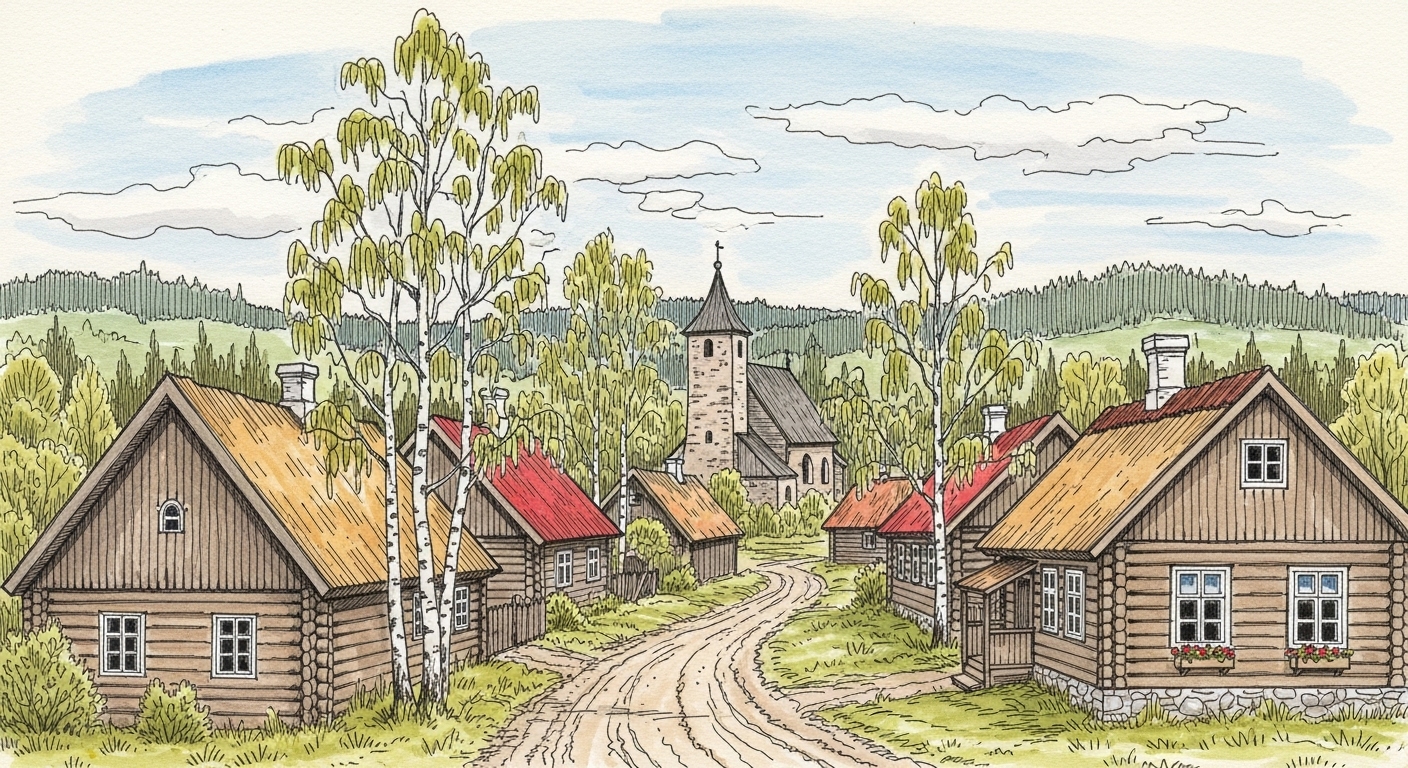You Can Read Estonian, But Can't Write It? Here’s the 3-Step Cycle to Fix That.
The Silent Frustration of the A2 Learner
You just finished reading a short article on an Estonian news site. You understood most of it - maybe 80%. You recognized the words, you followed the general plot, you felt a small flicker of pride. You’re making progress! 🚀
Then, you open your email to write a simple message to a colleague in Tallinn. Suddenly, your brain freezes. The words you just recognized so easily have vanished. You stare at the blank screen.
How do I say 'regarding the meeting'? Was it 'koosoleku kohta' or 'koosolekust'? Which case does the verb 'aitama' (to help) take again? I know the word for 'important', but how does the ending change after the word 'väga'?
It feels like trying to build a house when you only have a picture of the finished product, but no blueprint and no tools. You can see the language, but you can't build with it.
This gap between passive comprehension (reading, listening) and active production (writing, speaking) is the most common and frustrating wall A2 learners hit. It’s not a sign that you’re bad at languages; it's a sign that your learning method needs an upgrade. Flashcards got you here, but they won't get you to the next level.
What you need is not more memorization, but a process. A system that methodically converts the Estonian you absorb into the Estonian you can confidently create. This article will give you that system: a powerful 3-step practice cycle that you can start using today to bridge the reading-writing chasm for good.
The Active Production Cycle: From Consumer to Creator
The fundamental reason your writing lags behind your reading is simple: reading is an act of recognition, while writing is an act of creation. Creation is exponentially harder. It requires you to recall vocabulary from a cold start, assemble it with correct grammar, and structure it into coherent thoughts.
To become a writer, you must practice writing. But here's the dangerous paradox: practicing without feedback is just practicing your mistakes. You get better and better at writing incorrect sentences.
The solution is a closed-loop system: Read ➔ Write ➔ Get Feedback. Let's break down how to build this engine for your Estonian learning, step-by-step.
Step 1: Find Your Fuel - Strategic, Comprehensible Reading
Everything starts with input. You can't produce language you've never seen. But for an A2 learner, finding the right input is a huge challenge. Children’s books are too simple (Karu sööb mett - The bear eats honey) and native adult content is a wall of incomprehensible text. You need material that is just slightly above your current level - what linguists call "comprehensible input."
Your Mission: Find a short Estonian text (100-200 words) that you can understand about 70-80% of. You should get the main idea, but still encounter a few new words and structures.
Where to Look:
- Lastekas (err.ee): The children’s section of the Estonian Public Broadcasting has news articles written in simpler language. Look for
Uudised(News). - Keeleklikk: This online course has many A1/A2 level texts and dialogues that are perfect for this exercise.
- Simple Wikipedia in Estonian: While not officially a project, searching for simple Estonian articles can yield results.
- Graded Readers: Look for books specifically labeled for A2 Estonian learners.
How to Read Actively: Don't just skim. Read with a purpose. Have a notebook ready. As you read, jot down 3-5 words or short phrases that are new to you or that you find interesting. For example, if you're reading about a daily routine, you might see:
ärkan seitsme paiku- I wake up around seven.pärast hommikusööki- after breakfast.lähen tööle jalgsi- I go to work on foot.
Do not write down 50 words. Just a few key ones. The goal isn't to create a dictionary, but to prime your brain for the next, most important step.
Step 2: The Magic Bridge - Retell, Don't Translate
This is the core of the entire method. This is where the magic happens. After you've read your short text, close the tab or put the book away.
Now, open a blank document and try to rewrite the story or summary of the text in your own words. Do not peek!
Why is this so powerful?
- It forces active recall. Instead of just recognizing
pärast hommikusööki, you have to pull that phrase from your memory. This retrieval process is what builds strong memory pathways. - It reveals your true knowledge gaps. You might think you know how to use the partitive case, but when you're forced to write "I am eating an apple" (
Ma söön õuna), you suddenly have to confront whether it'sõun,õuna, orõunat. - It combines vocabulary, grammar, and sentence structure into a single, integrated skill.
Let's walk through an example.
Original A2 Text:
Anna on arst. Ta töötab suures haiglas. Igal hommikul ärkab ta kell kuus. Ta joob kohvi ja sööb putru. Pärast hommikusööki sõidab ta bussiga tööle. Haiglas aitab ta haigeid inimesi. Tema töö on raske, aga talle meeldib see.
(Translation: Anna is a doctor. She works in a big hospital. Every morning she wakes up at six. She drinks coffee and eats porridge. After breakfast, she rides the bus to work. In the hospital, she helps sick people. Her job is difficult, but she likes it.)
Now, you put that text away. Your mission is to retell it. Your first attempt might look something like this:
Your A2 Retelling Attempt:
Anna on arst. Ta töötab suur haiglas. Ta ärkab kell kuus igal hommikul. Ta joob kohvi ja sööb puder. Pärast hommikusöök ta sõidab bussiga tööle. Ta aitab haigeid inimestele haiglas. Tema töö on raske, aga ta meeldib oma tööd.
This is a fantastic first attempt! It's understandable, but it's full of classic A2 learning opportunities. You’ve successfully moved from being a passive reader to an active creator. But now comes the most critical part of the cycle.
Step 3: Find Your Mirror - The Unskippable Feedback Loop
Your retelling attempt is a snapshot of your current ability. Without feedback, it's just a bunch of sentences. With feedback, it becomes a personalized grammar lesson.
Your mission is to compare your text to the original and get corrections.
Manually, this is the hardest part. Here are your options:
- Self-Correction: Pull up the original text and compare it side-by-side with yours.
suur haiglasvs.suures haiglas. Ah, the inessive case (-s/s) needs the adjective to agree!suur->suures.sööb pudervs.sööb putru. Right, the object ofsöömais usually in the partitive case.puder->putru.aitab haigeid inimestelevs.aitab haigeid inimesi. This is tricky.Aitama(to help) takes the person being helped in the partitive.inimestele(allative case, 'to people') is wrong here.ta meeldib oma töödvs.talle meeldib see. The verbmeeldima(to like) is special. The person who likes is in the allative case (talle- to her), and the thing being liked is the subject.
- Language Partner: Find a native Estonian speaker on an app like Tandem or HelloTalk and ask them to correct your paragraph.
- Pros: It's free and you can make friends.
- Cons: It can be slow. Your partner is not a teacher and might not be able to explain why something is wrong. You might feel shy about asking for corrections constantly.
- Hire a Tutor: A professional teacher can give you excellent, detailed feedback.
- Pros: High-quality, personalized explanations.
- Cons: Can be very expensive and you have to schedule sessions in advance.
This manual cycle works. It is, without a doubt, a hundred times more effective than just reading or doing flashcards. But as you can see, the feedback step (Step 3) is a major bottleneck. It can be slow, expensive, or intimidating.
The Accelerator: Putting the Learning Cycle on Autopilot
This Read-Retell-Feedback cycle is the gold standard for developing active language skills. It’s how children learn, and it’s how you’ll finally break through the A2 wall.
Now, what if you could take this entire process and make it instant, infinitely repeatable, and guided by an expert tutor who is available 24/7?
This is precisely why we built Toritark. It’s not just another app; it’s a tool designed to execute this exact learning cycle for you, removing all the friction and bottlenecks.
Let's revisit the three steps and see how a tool can supercharge them:
Solving Step 1: An Endless Supply of Perfect Texts
Remember the struggle of finding A2-level articles? With Toritark, that problem disappears. You simply choose a topic you’re interested in - maybe "A conversation in a cafe" or "Planning a weekend trip" - and our AI generates a brand new, unique story perfectly tailored to your skill level. You get an infinite stream of interesting, comprehensible input on demand. No more hunting for articles that are too hard or too boring.
While reading the story in the app, if you hit a word you don't know, you just long-press it to save it to your personal vocabulary list. No more switching apps to a dictionary, losing your flow.
Automating Step 2: The Guided Retelling
Toritark bakes the magic retelling step right into the learning process. After you read the story and answer a quick comprehension quiz to make sure you understood the plot, the app presents you with a blank page and a simple prompt: "Now, retell the story in your own words."
It turns this crucial-but-often-skipped step into the main event. It guides you to actively produce the language you just consumed, cementing your learning in the most effective way possible.
Revolutionizing Step 3: Instant, Granular Feedback
This is where everything changes. Instead of waiting for a language partner or paying for a tutor, you get immediate, detailed feedback on your writing from our AI.
Remember your retelling attempt from our example?
Anna on arst. Ta töötab suur haiglas. ... Ta aitab haigeid inimestele haiglas. ... aga ta meeldib oma tööd.
After you submit this text in Toritark, you don’t just get a generic “good job.” You get an incredible, multi-layered analysis:
- An Overall Score: To track your progress over time.
- Side-by-Side Corrections: It shows your text next to a corrected version, with every single change highlighted.
- Detailed Breakdown: You get separate scores for Grammar, Vocabulary, Spelling, Punctuation, and Completeness so you know exactly where to focus.
- Actionable Explanations: This is the game-changer. For each correction, Toritark explains why it was wrong, in your native language. It would tell you:
- "In the phrase
suures haiglas, the adjectivesuurmust be in the same inessive case (-s) as the nounhaigla." - "The verb
sööma(to eat) requires its object to be in the partitive case. The partitive form ofpuderisputru." - "The verb
meeldima(to like) has a unique structure. The person doing the liking is in the allative case (talle- to her), not the nominative (ta)."
- "In the phrase
It’s like having a dedicated Estonian linguist available 24/7, ready to analyze every sentence you write and give you the precise feedback you need to improve.
Close the Loop: Master Vocabulary in Context
Finally, Toritark takes all those words you saved while reading and the vocabulary you struggled with in your writing, and creates personalized quizzes. But these aren't your typical flashcards. It generates fill-in-the-blank exercises using the exact sentences from the stories you read. So you practice putru not as an isolated word, but in the sentence Ta sööb ____., reinforcing the grammar and context automatically.
Your Turn to Write
The gap between reading and writing Estonian is not a wall, but a river. You can't cross it by staring at the other side (reading more) or by just wishing you were there. You have to build a bridge.
The Read ➔ Write ➔ Get Feedback cycle is that bridge. It’s a reliable, effective method for turning your passive knowledge into an active, creative skill.
You have the blueprint. You can start today with a notebook and a news article.
Or, if you want to accelerate your journey, remove the friction, and get the kind of instant, expert feedback that was never before possible, you can start your first learning cycle on Toritark in the next five minutes. Stop being just a reader. It's time to become a writer.
Finally, Speak with Confidence
📖 Read short stories adapted to your level.
✍️ Retell them & get instant AI corrections on your writing.
🧠 Master new words in their real context.
Similar posts

The Estonian Reading-Writing Chasm: Why You Understand More Than You Can Produce (And How to Bridge It)
Feel like your Estonian understanding is miles ahead of your writing skills? You're not alone. Discover a powerful 3-step method to close the gap and turn passive knowledge into active fluency.

The Estonian Object Puzzle: Why ‘Ma Lugesin Raamatu’ vs. ‘Raamatut’ Changes Everything
Stuck at the B2 level in Estonian? Master the subtle difference between partitive and genitive objects to make your writing sound precise, natural, and fluent. This is the key.

Your Italian Vocabulary Is Trapped in Your Head. Here’s How to Get It Out.
Feeling like you 'know' Italian words but can't use them? You're not alone. Discover a powerful cycle to move vocabulary from passive memory to active use and finally start writing with confidence.

Your Estonian Is Stuck in a Loop of 'Almost' Correct: Here’s How to Break It
Feel like you're making the same Estonian mistakes over and over? This guide provides a powerful self-correction method to find and fix hidden errors in your writing.

Your Estonian Sentences Are Islands. Here's How to Build the Bridges.
You can write correct Estonian sentences, but do they connect? Learn how to use connectors, referencing, and varied structures to create writing that flows, not just states facts.